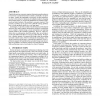667 search results - page 70 / 134 » Making decisions based on the preferences of multiple agents |
IAT
2010
IEEE
13 years 7 months ago
2010
IEEE
Abstract--In this paper, we study the method of ranking intuitionistic fuzzy numbers. Firstly a possibility degree formula is defined to compare two intuitionistic fuzzy numbers. W...
WSC
2000
13 years 10 months ago
2000
Simulation models are often not used to their full potential in the decision-making process. The default simulation strategy of simple serial replication of fixed length runs mean...
WINE
2005
Springer
14 years 2 months ago
2005
Springer
This paper takes the first steps towards designing incentive compatible mechanisms for hierarchical decision making problems involving selfish agents. We call these Stackelberg p...
AMEC
2003
Springer
14 years 2 months ago
2003
Springer
Digital information economies require information goods producers to learn how to position themselves within a potentially vast product space. Further, the topography of this spac...
AAAI
2006
13 years 10 months ago
2006
Voting (or rank aggregation) is a general method for aggregating the preferences of multiple agents. One important voting rule is the Slater rule. It selects a ranking of the alte...

